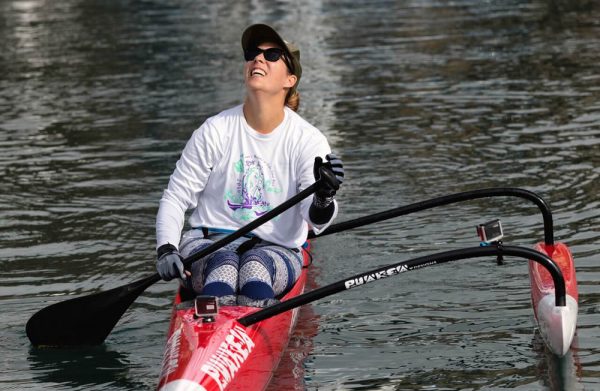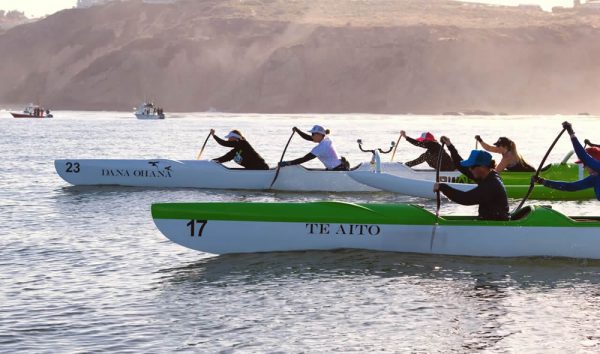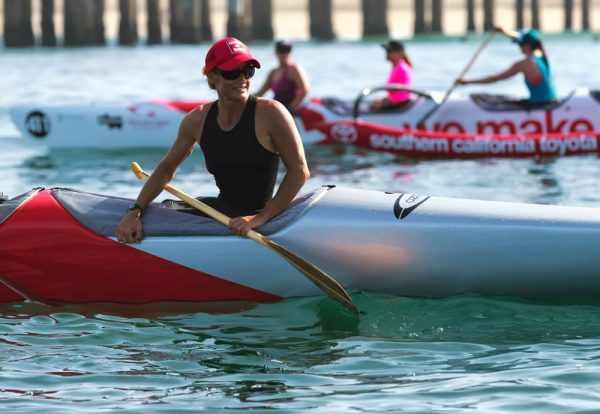
Courtney Hamchuck spied them while jogging in Dana Point Harbor, a cluster of women paddling canoes on the water. A surfer who had played soccer in college at San Francisco State, the Laguna Beach resident was looking for a new workout. Now, five years later, Hamchuck is a volunteer coach and competitive paddler with the Dana Point Outrigger Canoe Club, which has 90 active members.
Outrigger paddling, the national sport in Tahiti and the state sport of Hawaii, is dominated by men in those locales, but in Southern California“the dynamic is turned on its head,” said Dan Brockett, a Camarillo filmmaker who is currently producing “Year On the Water,” a documentary about the 2018 Southern California outrigger paddling season, which ends in September.
Brockett owes a debt to his wife’s avocation paddling with the Hokuloa Outrigger Club in Ventura for the film’s inspiration. As his wife, Elisabeth Creighton,“progressed deeper into the sport, I began to notice interesting and compelling details about how the sport of outrigger and women’s roles in it have evolved in Southern California,” he said.
“I spent a lot of time at the races, watching how the women pull together as a team to win and how different the dynamic was between the women’s, co-ed and men’s teams,” Brockett added. He and co-producer Tony Peck, both fathers of daughters, “felt compelled to tell a story that would show strong women, accomplishing whatever they set their minds to.”
The film explores the world of outrigger canoe paddling through the eyes Hamchuck and Aimee Spector, a 13-year member of the Redondo Beach Lanakila Outrigger Canoe Club, which has slightly more female than male members. “The story is a character study about these two strong, independent women, in the guise of a sports documentary,” Brockett said.
Spector grew up surfing in the South Bay and found outrigger paddling through a friend’s recommendation. While living in Playa del Rey after attending UC Santa Cruz, she joined a club in Marina del Rey where she competed for eight years before moving to the Redondo Beach club.

Hamchuck, who earned a master’s degree in business and marketing at UC Irvine, works in the marketing department of Hyundai Capitol American in Irvine. She starts her day with a workout at the gym or on the water and returns to the harbor to practice with other paddlers from 6-9 p.m. each evening.
Spector works as a special needs high school teacher. The single mother rises at 5 a.m. two days a week to paddle and manages to squeeze in running and cross fit training between her carpool responsibilities and her son’s soccer practices. “I want to be in the best shape possible so I’m of use in the boat,” she said. Tuesdays she rests, but on the weekends she practices with other available team members who are also “moms with jobs.”
Competing in the open ocean presents some risk, both obvious and unexpected.
“They are there,” Spector said, of sharks, which have been spotted in increasing number off local shorelines. “But I’ve never had an incident, even while prone paddling,” she said. “I’m less afraid of wildlife than I am of boats that don’t see me,” said Spector, who was hit by a boat in 2006.
Despite its name, the Dana Point Outrigger Canoe Club is little more than a storage shed in the harbor parking lot. Members’ dues cover the cost of the boats, insurance and race fees, which range from $54 per crew for short races and up to $500 for a championship race. Generally there is no prize money for winners. Race participants pay for escort and race boat rentals and traveling expenses for out-of-town races. “It’s an expensive sport,” said Hamchuck, who last year competed in a “big race” in Tahiti.

Race season began in May in San Diego and will conclude with the championship Catalina Crossing, 26 miles from Newport Beach to Avalon, in September.
Race events include sprints, sprint relays and nine-man races, which involves rotating personnel in a six-man boat using a motorboat alongside the canoe. The sixth seat steers the boat. “The steersman must be confident, assertive and have a fundamental understanding of the water,” Spector said.
“The Catalina Crossing qualifies you to do the Na Wahine O Ke Kai, a 42-mile race in Hawaii,” said Hamchuck, who usually competes in one “big race” each year. This year she’s hoping to make it to Australia.
Having produced marketing, promotional and behind-the-scenes content for the networks and studios, Brockett and Peck have thus far self-funded Go-Pro cameras, boats and other expenses involved in making their first documentary.
To raise the remaining $30,000 to shoot the final six races taking place in Dana Point, San Diego, Long Beach and Oceanside, Brockett and Peck have started an IndieGoGo crowd funding campaign. They aim to finish and submit their film for consideration in next year’s spring and summer festivals and find a permanent home for it on major streaming services.




